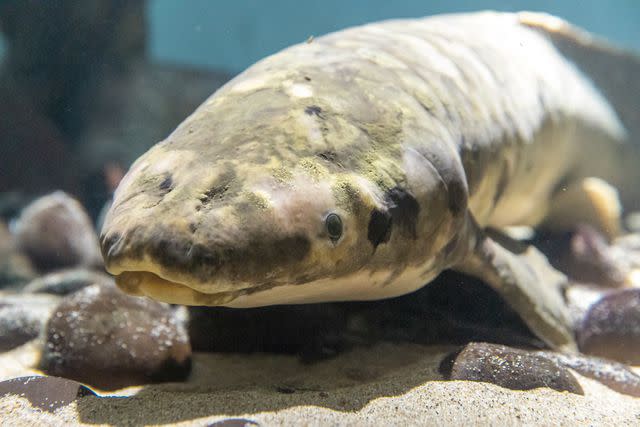The World’s Oldest Aquarium Fish Is Older Than Scientists Originally Thought, New Study Finds
Scientists at the California Academy of Sciences say that the Australian lungfish, Methuselah, may even be older than 100 years old

Gayle Laird, California Academy of Sciences
Methuselah the nonagenarian Australian lungfish who resides at the Steinhart Aquarium in San FranciscoScientists say the world’s oldest aquarium fish is likely older than they originally thought.
The California Academy of Sciences (CAS) revealed on Monday that the Australian lungfish Methuselah, who resides in Steinhart Aquarium in San Francisco is estimated to be 92 years old — nine years older than her previous estimated age of 84.
Methuselah arrived at the Steinhart Aquarium in 1938 and outlived 231 other fish from Fiji and Australia that arrived with her, according to a CAS press release. She is considered the oldest living fish in an aquarium anywhere in the world.
Scientists estimate that she might be able to live up to 101 years and could celebrate her centennial birthday in a few years, as the CAS’ Steinhart Aquarium also celebrates its 100th anniversary on Sept. 29.
Related: Bobi, the World's Oldest Dog Ever, Turns 31 and Celebrates with a 100-Person Birthday Bash
"Although we know Methuselah came to us in the late 1930s, there was no method for determining her age at that time, so it’s incredibly exciting to get science-based information on her actual age,” said Charles Delbeek, curator of aquarium projects at Steinhart Aquarium.
“Methuselah is an important ambassador for her species, helping to educate and stoke curiosity in visitors from all over the world,” Delbeek added. “But her impact goes beyond delighting guests at the aquarium: Making our living collection available to researchers across the world helps further our understanding of biodiversity and what species need to survive and thrive.”
Methuselah and the Academy’s two other lungfish, who are approximately 54 and 50 years old, were included in a study to help further advances in approximating the fish’s age. Their DNA was sampled using a tiny tissue sample collected from their fins, which the Academy noted would not impact the fish’s health.

Gayle Laird, California Academy of Sciences
Methuselah the lungfish, the world's oldest living aquarium fish, at the Steinhart AquariumRelated: Rescued Alligator with Top Half of Jaw Missing Finds New Home at Florida Park
The DNA of the Academy’s three lungfish and 30 other lungfish from six other institutions were taken to create a catalog which would “advance the accuracy of the previously developed DNA-based age clock for the species,” according to the Academy.
“For the first time since the Australian lungfish’s discovery in 1870, the DNA age clock we developed offers the ability to predict the maximum age of the species,” said Dr. Mayne, one of the leaders of the study.
He continued, “Accurately knowing the ages of fish in a population, including the maximum age, is vital for their management. This tells us just how long a species can survive and reproduce in the wild, which is critical for modeling population viability and reproductive potential for a species.”
However, his partner Dr. Roberts admitted that approximating Methuselah’s age was “challenging to calculate” as her “age is beyond the currently calibrated clock.” This means that she still might be older than their calculations and even over the age of 100.
Never miss a story — sign up for PEOPLE's free daily newsletter to stay up-to-date on the best of what PEOPLE has to offer, from juicy celebrity news to compelling human interest stories.
Dr. Mayne and Dr. Roberts are set to publish their study on the lungfish's age later this year. Their original method development paper provides a description of how scientists can estimate a threatened fish’s age through DNA methylation methods.
“This research highlights the important and often serendipitous discoveries that can occur from working with public aquariums and institutions that maintain protected species in their care,” said Dr. Roberts. “This approach to researching longevity of rare and endangered animals could be extrapolated to almost any vertebrate species, and demonstrates the value that animal care institutions such as the California Academy of Sciences can play in advancing animal knowledge to improve conservation management of species in the wild.”
For more People news, make sure to sign up for our newsletter!
Read the original article on People.


